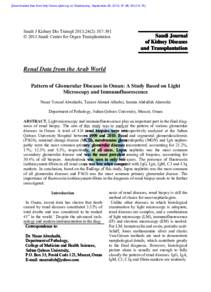وثيقة
Pattern of glomerular diseases in Oman : a study based on light microscopy and immunofluorescence.
المعرف
DOI: 10.4103/1319-2442.109616
المساهمون
الناشر
Saudi Center for Organ Transplantation.
ميلادي
2013-03
اللغة
الأنجليزية
الملخص الإنجليزي
Light microscopy and immunofluorescence play an important part in the final diagnosis of renal biopsy. The aim of this study was to analyze the pattern of various glomerular diseases in Oman. A total of 424 renal biopsies were retrospectively analyzed at the Sultan Qaboos University Hospital between 1999 and 2010. Focal and segmental glomerulosclerosis (FSGS), minimal change disease (MCD), membranous glomerulopathy (MGN) and IgA nephropathy were the most common primary glomerular diseases encountered, accounting for 21.2%, 17%, 12.3% and 8.3%, respectively, of all cases. Lupus nephritis was the most common secondary glomerular disease and was the most prevalent among all biopsies, accounting for 30.4% of all biopsies. Amyloidosis was seen in only two cases. The presence of fluorescein isothiocyanatefibrin in all renal cases was low when compared with IgG, IgA, IgM, C3 and C1q markers. In conclusion, based on the findings of this study, lupus nephritis was the most common of all glomerular diseases and FSGS was the most common primary glomerular disease. The importance of fluorescein isothiocyanate-fibrin in the diagnosis of renal biopsy needs to be further investigated.
المجموعة
ISSN
1319-2442
URL المصدر
قالب العنصر
مقالات الدوريات

